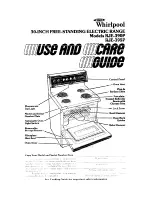
2. Installation instructions
2.1. Position of the unit
- The position of the appliance must be chosen very care-
fully in order to obtain the best possible results for heat
distribution.
- Position the unit to comply with the minimum clearances
to combustible material. Minimum clearances are shown
from the vertical portion of the chimney connector. Check
that no overhead cross members in the ceiling will be cut.
Reposition unit if necessary, being careful not to move
closer than the minimum clearances.
2.2. Chimney
- Ensure that the flue has sufficient draught (refer to tech-
nical details).
- Minimum flue diameter, 10 cm (4" I.D).
- The chimney must be at least 4.5 m (15 ft high).
- The flue must not be shared with any other appliance.
- Downdraughts caused by obstacles close to the chimney
top may sometimes be prevented by fitting an anti-down-
draught cap to the top of the chimney.
- The chimney must have a constant cross section. Too
large a flue could affect the chimney draught.
- The chimney must be soundly constructed, in order to
prevent cold air infiltration.
- The flue must be well insulated, water and air tight. A
chimney with a cold internal surface can prevent a good
chimney draught and condensation will occur.
-The flue must be swept at least once a year.
2.3. Chimney connector
- The appliance must be as close as possible to the chim-
ney. Avoid horizontal flue connection pipes which can
dangerously restrain functioning of the appliance.
- The connector pipe should be standard black painted or
blued steel pipe of not less than 30 gage; 304 grade
stainless steel of not less than 30 gage; or 1 mm viterous
enamelled steel, with a maximum diameter of 5 inch O.D.
- (127 mm). It is the installer’s responsability to conform to
local building standards and requirements with regard to
installation.. Single wall pipe may be utilized being careful
to maintain clearances to any combustible surface.
Once the stove has been properly installed the chimney
draught must be checked with a draught meter.
If the chimney draught is excessive or irregular, a draught
stabilizer (barometric damper) must be installed to the
connector pipe.
2.4. Levelling
Figure 3 and 4
It is essential that the appliance sits level on the floor. Fit
the 4 screws and the 4 caps supplied (on the burner) on
the feet. Use a spirit level to check.
2.5. Mounting the tray
Figure 6
To avoid damage to the ash tray during transport, it has
been disconnected and stored behind the main door of the
oil stove. To reinstall the ash tray to the front of the oil
stove, tilt the tray at a 45
°
angle, center onto tab ‘A’ and
lower into place.
2.6. Fitting of the handle
Figure 5
In order to avoid the damaging of the threading, first put
the handle in operating position then screw it into the
taping of the lock.
2.7. Fitting the “visioflamme”
Fit the glasses (# 59, p. 22) onto the reflector (# 28, p. 22).
7
2
3
4
5 6
9
8
10
1
11
Ill. 2 - Cross section
1 - Blanking plate
(not provided to be
connected to the
chimney).
2 - Main door.
3 - Opening and closing
of the lower door.
4 - Catalyser top.
5 - Upper ring.
6 - Catalyser.
7 - Flue collar.
8 - Reflector.
9 - Burner.
10 - Tray
11 - Screws
Document n° 809-5EN ~ 15/04/1999
Burgundy Oil burning stove
16 Technical manual






























